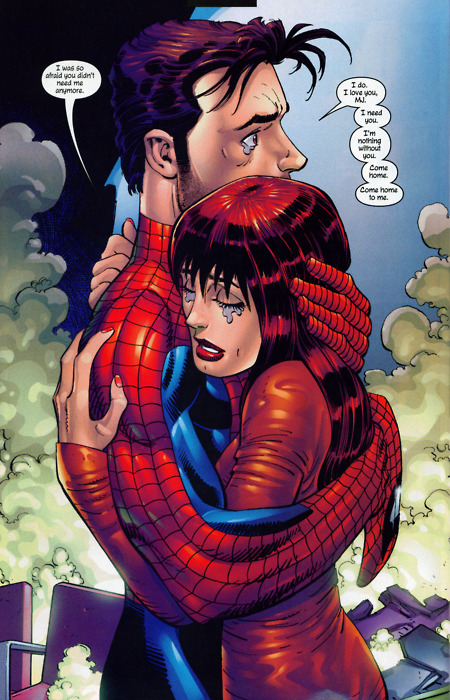The reverse of the argument that Spider-Man’s marriage didn’t matter is the claim that it had become ingrained as a core part of the series, and represented something that can’t be changed without doing great harm to the franchise. Fans of Spider-Man’s marriage suggest that all previous attempts to reverse it have failed, and that a careful analysis of sales data will confirm that the Spider-Man comics would be selling much better if only Quesada hadn’t pushed through a controversial change to the status quo.
During the Brand New Day era, discussions of ICV2 sales estimates for Amazing Spider-Man were among the most contentious at the Spider-Man board at Comic Book Resources. Spider-Man’s the best character in comics, and the material should reflect that, but it was ridiculous when some of the detractors of One More Day suggested that unless the book was unambiguously more successful in the Brand New Day period than it was during the earlier J. Michael Straczynski era, the decision to retcon away the marriage was a failure.
No one at Marvel suggested that this one change promised a sudden level of sustained greatness, in quality or in sales. But this seems to be the implicit understanding of many commentators in various sales discussions. Granted, taking the comments of people you disagree with out of context, or inventing straw men arguments out of whole cloth, is hardly unique to comic book message board quarrels.
Before One More Day, sales of Amazing Spider-Man were higher than they had been in a long time. There were two major reasons for that. Writer J. Michael Straczynski was an A-lister, one of the biggest names in comics, fairly well-known in the film and television industry as well. And for the previous two years, every issue of the book was part of a highly promoted Event. The five issues of Back in Black followed ten issues of Civil War tie-ins, which followed “The Other” crossover.
These were not reasonable baseline figures for Spider-Man comics, even before factoring the added cost of buying several copies a month when the satellite titles were folded into Amazing Spider-Man, an approach I’ll analyze in more detail later. Implying that these numbers were the norm suggests that one either took the marriage too seriously, or expected others to have inflated expectations regarding the significance of One More Day.
I could understand that some readers couldn’t imagine the book without the marriage. The first Spider-Man comics I had read featured Peter Parker happily married to Mary Jane Watson, in the newspaper strip published in the Daily News. I graduated to the regular comics right before the Clone Saga started. When I was able to buy the book regularly, the Clone Saga had just ended and Peter Parker was married to MJ again. While the Fox animated cartoon and various reprints showed the character as a bachelor, it seemed natural that all stories would lead to these two crazy kids happily married to one another.
So I understand why for some people the marriage was a sacred cow: something that had become close to a permanent fixture in the titles.
The perception was that there had been two attempts to shake up the status quo of the book, and both were unsuccessful. Eight years after the wedding, it was revealed in “The Trial of Peter Parker” that the Spider-Man who was the lead character of a new monthly was a clone, and that the man who thought he was the clone was actually the real Peter Parker. Although that was reversed rather quickly. When Mary Jane’s plane exploded in Amazing Spider-Man Volume 2 #13, the readers knew she wasn’t on board. She returned in Howard Mackie’s final storyline, in which she left Peter to go find herself in the aftermath of a traumatic experience. When JMS teased a reunion between the two in Amazing Spider-Man Volume 2 #50, we also knew how it would end.
The changes demonstrated just how interested the writers were in shaking things up, and how the marriage wasn’t very stable from issue to issue. However, the stories always ended with Peter and MJ back together, which suggested the resiliency of the relationship. It was part of the comics for two decades, and it was just taken for granted.
And then things changed.



